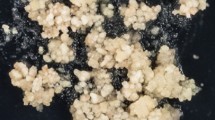Abstract
Nucellar-derived cell cultures of sour orange (Citrus aurantium L.) proliferate as proembryogenic masses. By a change in the carbon source of the medium from sucrose to glycerol they are induced to undergo synchronous embryogenesis forming embryo initials that develop into globular embryos. The proembryogenic masses released glycoproteins to the medium. Exogenous addition of the glycoproteins to cells in glycerol-containing medium modified the course of embryo development in a dose-dependent manner. Addition of 20 μg · ml−1 of glycoproteins blocked embryogenesis and resulted in an accumulation of embryo initials. When glycoproteins were added to cultures containing advanced globularstage embryos further development was suppressed. The inhibitory component of the glycoproteins was found to be a family of polypeptides with apparent molecular masses of 53–57 kDa. While these proteins normally accumulated only in cultures of proembryogenic masses, they could be induced to accumulate in glycerol-containing medium by the addition of the glycoproteins. Thus, their accumulation was not a direct consequence of the type of growth medium used or the developmental state of the cultures. The results indicate that the 53-to 57 kDa glycoproteins could play a regulatory role in in-vitro embryogenesis in sour orange. The normal progression of embryo development appears to depend, in an obligatory manner, on the absence of these glycosylated extracellular proteins from the medium.
Similar content being viewed by others
Abbreviations
- kDa:
-
kilodalton
- PEM:
-
proembryogenic masses
- SDS-PAGE:
-
sodium dodecyl sulphate-polyacrylamide gel electrophoresis
- 2D-PAGE:
-
Two-dimensional polyacrylamide gel electrophoresis
References
Bacchi, O. (1943) Cytological observation in Citrus. III. Megaspo-rogenesis, fertilization, and polyembryony. Bot. Gaz. 105, 221–225
Ben-Hayyim, G., Neumann, H. (1983) Stimulatory effect of glycerol on growth and somatic embryogenesis in Citrus callus cultivars. Z. Pflanzenphysiol. 110, 331–337
Blum, H., Beier, B., Gross, H.J. (1987) Improved silver staining of plant proteins, RNA and DNA in polyacrylamide gels. Electrophoresis 8, 93–99
Button, J., Kochba, J., Bornman, C.H. (1974) Fine structure of and embryoid development from embryogenic ovular callus of ‘Shamouti’ orange (Citrus sinensis Osb.). J Exp. Bot. 25, 446–457
Dougherty, W.J. (1981) Preparation of semi-thin sections of tissues embedded in water-soluble methacrylate for light microscopy. In: Staining procedures, pp. 27–38, Clark, G., ed. Wilkins and Wilkins, Baltimore, USA
de Vries, S.C., Booij, H., Janssens, R., Vogels, R., Saris, L., Lo-Schiavo, F., Terzi, M., van Kammen, A. (1988) Carrot somatic embryogenesis depends on the phytohormone-controlled presence of correctly glycosylated extracellular proteins. Genes Dev. 2, 462–476
Gavish, H., Vardi, A., Fluhr, R. (1991) Extracellular proteins and early embryo development in Citrus nucellar cell culture. Physiol. Plant. 82, 606–616
Laemmli, U.K. (1970) Cleavage of structural proteins during the assembly of the head of bacteriophage T4. Nature 227, 680–685
LoSchiavo, F., Giuliano, G., deVries, S.C., Genga, A., Bollini, R., Pitto, L., Cozzani, F., Nuti-Ronchi, V., Terzi, M. (1990) A carrot cell variant temperature sensitive for somatic embryogenesis reveals a defect in the glycosylation of extracellular proteins. Mol. Gen. Genet. 223, 385–393
Murashige, T., Tucker, D.P.H. (1969) Growth factor requirements of Citrus tissue culture. In: Proc. 1st Int. Citrus Symp., vol. 3, pp. 1151–1161, Chapman, H.D., ed. University of California, Riverside, USA
O'Farrell, P.H. (1975) High resolution of two-dimensional electrophoresis of proteins. J. Biol. Chem. 250, 4007–4021
Satoh, S., Fujii, T. (1988) Purification of GP57 an auxin-regulated extracellular glycoprotein of carrots, and its immunocytochemical localization in dermal tissues. Planta 175, 364–373
Vardi, A., Galun, E. (1988) Recent advances in protoplast culture of horticulture crop. Citrus Scient. Hort. 37, 217–230
Williams, E.G., Maheswaran, G. (1986) Somatic embryogenesis: Factors influencing coordinate behavior of cells as an embryogenic group. Ann. Bot. 57, 443–462
Author information
Authors and Affiliations
Additional information
We thank Dr. S. Satoh (Institute of Biological Sciences, Tsukuba, Japan) for sending protein samples of the purified 57-kDa glycoprotein. This research was supported by a grant from the Charles H. Revson Foundation for Basic Research in the Life Sciences of the Israel Academy of Sciences. R.F. is a recipient of the Jack and Florence Goodman Career Development Chair.
Rights and permissions
About this article
Cite this article
Gavish, H., Vardi, A. & Fluhr, R. Suppression of somatic embryogenesis in Citrus cell cultures by extracellular proteins. Planta 186, 511–517 (1992). https://doi.org/10.1007/BF00198030
Received:
Accepted:
Issue Date:
DOI: https://doi.org/10.1007/BF00198030




